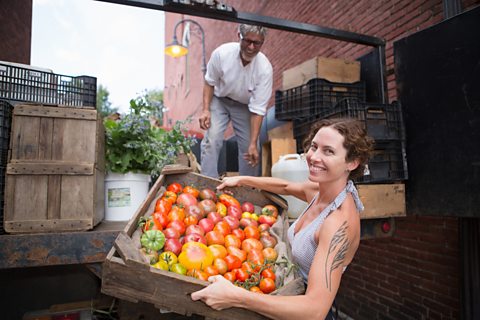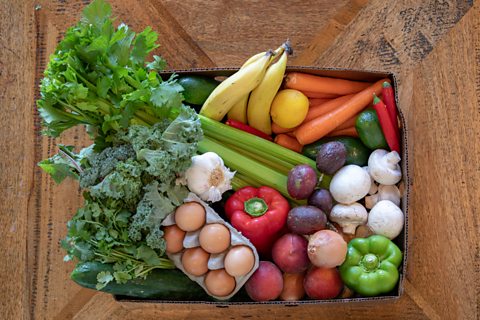Is the UK on the brink of a revolution in how we buy food?

тАЬWe could тАУ if we donтАЩt go back to our bad old ways тАУ be in the middle of a food revolution.тАЭ
WeтАЩre talking to farmer Dr Phil Morley about the impact of COVID-19 on the availability of affordable food when the conversation takes an unexpected turn. It quickly moves on to how changes in our shopping habits during lockdown could transform our attitudes to food тАУ for the better.
His opinion could be seen as a one-off. That is, until we speak to further experts and hear the same positive message. So could the UK be about to embark on a food revolution? And if so, what does that mean?
What would a food revolution involve?

тАЬThere has been an upsurge in local box schemes, producers supplying their local market and direct sales to housesтАЭ, says Dr Phil, who is technical officer of the British Tomato GrowersтАЩ Association. тАЬThough itтАЩs not currently very profitable [for the food producer], it looks like consumers and producers might have formed that habit now.тАЭ
Liz Bowles, Associate Director for Farming and Land Use at the Soil Association, also recognises the potential for change. тАЬThereтАЩs a huge opportunity to think about what food looks like, not only the cost of it, but what goes into it, how itтАЩs produced and what impact itтАЩs having on our climate, the health of our consumers and natureтАЭ.
Could we see a shorter food chain?
тАЬI think a lot of people are feeling more connected to food and really thinking about where it comes fromтАЭ, says Liz, before quickly adding, тАЬperhaps a shorter supply chain is better тАУ and would help to alleviate any potential food shortages if there was another wave of COVID-19. If you have a really long food supply chain and one part of it goes wrong, itтАЩs hard to reconfigure all of that.тАЭ
So what does a shorter food supply chain look like? Well, itтАЩs exactly what it sounds like: having fewer people/businesses involved, from the food being produced to reaching the consumer. And, over the last few months тАУ whether thatтАЩs ordering food from a or going to a direct rather than stumbling across them in a shop тАУ it seems weтАЩve been actively making it happen.
тАЬWe need to create new, shorter, localised supply chains, where there are fewer people involved and the chain is less likely to breakтАЭ, says Romilla Arber, owner of The Honesty Group, which operates nine coffee shops, a hotel and restaurant.
Many local businesses have been responding to the changes in consumer habits. Alison Lea-Wilson, co-founder of Halen M├┤n Anglesey Sea Salt and a member of the Food and Drink Wales Industry Board, has a caf├й and visitor centre, says тАЬweтАЩre working more online, and with other producers so we can sell their products online. The chef has turned from working in our caf├й to making provision boxes, which include produce we grow as well as staples and treats. WeтАЩve been able to offer a click-and-collect service tooтАЭ. She says the local community pulling together has helped them to keep going. TheyтАЩve even diversified their business by setting up a pizza takeaway service for locals тАУ something they plan to continue once тАШnormal lifeтАЩ resumes.
In terms of selling online, itтАЩs not just customers theyтАЩve been reaching, but businesses around the world too тАУ something that would have been inconceivable without the acceleration in technology. тАЬThe Welsh government has been doing these great virtual trading missions. IтАЩve тАШbeenтАЩ to one to Singapore and weтАЩve sent a small order out, which is fantastic. And IтАЩm in the middle of one for AustraliaтАЭ.
How will technology help change the way we buy food?

All the experts we spoke to mentioned the effect technology has had on their businesses and the industry over the last few months тАУ not just at a local level. Barilla, based in Italy, is a huge pasta producer. Given the increase in demand for pasta at the start of the health crisis, you could be forgiven for thinking they might not have needed to think about how to keep their business up and running. But they faced a different issue тАУ how to meet increased demand.
Alberto Costella, Marketing Manager for Export Market at Barilla, says there have been both positives and negatives. тАЬThe increased pressure [to keep up with demand] means increases in costs throughout the whole supply chain, so we tried to save non-essential expenses to absorb higher costs and not pass these onto consumers.тАЭ
Now there is more of a feeling of normality, will they go back to their previous way of running things? Not quite.тАЬWe need to consider that the pandemic has changed consumer consumption habits, not just in terms of what people are buying but how theyтАЩre buying it. Whether thatтАЩs sourcing more local produce or increasing online grocery shopping, these are all elements that the supply chain will need to adapt to going forwards.тАЭ
ItтАЩs not just how businesses reach customers and clients thatтАЩs changing, but also how food is produced. Dr Phil explains that technology is people farm. тАЬIn some sectors, theyтАЩre moving on very, very quickly, with automation, including robotics and AI being used to help pick produce. [The health crisis] pushed that whole agenda forward and itтАЩs been fast tracked. I think that could help us prepare for a future where maybe thereтАЩs less access to labour than there has historically been.тАЭ
Will we really be able to keep up our new habits?

This, of course, is the great unknown, and will be impacted by the price and ease of buying food. Would consumers be willing to pay a little more for locally produced food, and buy their weekly shop from various shops and food producers rather than just popping to a supermarket?
Mike Warner, ambassador for non-departmental public body Seafish, says in the south of England тАЬhome deliveries have thrived, with fish box schemes and online sales booming. This has meant a whole new era of high-quality product access has been created and consumers are far better able to appreciate the native fisheries resources we have in the UK.тАЭ He says if UK consumers want to continue buying, even if prices increase, тАЬthis is the step change in the seafood eating culture that has been desired for so long.тАЭ
MikeтАЩs final comment sums up how many in the food industry тАУ especially in food production тАУ feel. They hope the short-term changes we have seen could lead to a long-term food revolution.